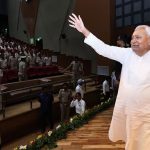Breaking News
A glimmer of hope amid media pollution
 Amit Khanna
Amit Khanna
 Amit Khanna
|
13 Oct, 2020
Amit Khanna
|
13 Oct, 2020
/wp-content/uploads/2020/10/Media.jpg)
When those whose job is to deliver news start grabbing headlines, then be sure there’s something going amiss. The past few months have seen TV news channels embroiled in one controversy after another. It started with the death of a young star from Bollywood. A cross-channel debate fuelled by heightened passions across fandom, politics and regional loyalties, TV channels started sparring on this unfortunate tragedy on a sustained basis. In a matter of weeks, all kinds of issues were dragged into it, and since then television is anarchy. Not one channel is reporting facts but all are presenting their version of leaked information and individual grouses. Now this battle for eyeballs has turned into a war about viewership numbers and TV ratings. While any sample survey is susceptible to errors, even manipulation, this controversy is highly exaggerated. Half-baked knowledge of the measurement system is leading to an ill-informed debate. Let’s not forget for several years these same channels have sliced and diced data to claim audience leadership. The problem is endemic and there is no point blaming others for their own mess.
In the last decade, journalism has not only been partisan but also irresponsible and shoddy. In no other country, there are 300-plus news channels in over 20 languages. However, a reality never mentioned by the newscasters is that less than 10 per cent of India watches news. If we narrow it down further to English and Hindi, this figure will come down to about 2.5 per cent. Social media apps like Facebook, Twitter, Instagram and WhatsApp have ensured the noise of news is amplified manifold. Interestingly, a vicious cycle of regurgitation of news works round-the-clock where someone posts a news item (some genuine, some imagined, many half-truths), a newspaper or TV channels picks it up and follows with a story, usually by some stringer, or information is gleaned from another source. The TV channel then, depending on its desperation and political leaning, sends a reporter and camera crew and starts breaking news (no pun intended). It’s now time for the troll armies, other journalists, activists, politicos to go on a social media leather hunt and quote hangers appear by the dozen across hundreds of channels, each one with a prejudiced mind.
Broadcast news is the dominant source of news and information across the world for over decades. In India, the news bandwagon appeared in the late nineties There’s been no looking back for broadcast news since then, despite India being one of the few countries in the world where print media is still growing. The immediacy of news and its audio-visual nature and widespread distribution has made TV the primary news platform in India. No wonder India has over 400 news channels in 23 languages battling for not only audience attention but also advertising and channel space across platforms. Private news networks were given licences to broadcast news in India. This became a turning point. It didn’t take long for people to discover the difference between sarkari and independent news. There was a lot more reportage with smart visuals and good graphics. The emphasis was on news and boring discussions were kept to a minimum. Hot switching (between studio and location) multiple feeds were encouraged. You could see an earnest desire on the part of these channels to pursue excellence. Of course, there was political bias and partisanship, but it was not all-pervasive. Young, enterprising and trained reporters and crews were often on the sidelines of history as events unfolded. There was immediacy to news aided by technological leap provided by digitisation and satellite, mobile and internet-based communication. The Indian audience finally had several options to get informed and know what was happening around them. But alas, this happy situation was to last only a few years.
Some key lessons were forgotten. Several decades ago, one of the founding fathers of modern journalism Walter Lippmann wrote: ‘The press is like a roaming spotlight, bouncing from topic to topic, story to story, illuminating things but never fully explaining them. The function of news is to signalize an event, the function of truth is to bring to light the hidden facts, to set them into relation with each other, and make a picture of reality on which men can act.’ This may appear simple, but is the crux of the problem. Media vehicles decide where they want to go with a story. So, who you talk to, what questions you ask and how much of the answers you retain, what is seen and said, determines the final outcome? It does not make an iota of difference whether the perspective is decided by the owner, editor, journalist, advertiser or even the government. The fact is objectivity is fiction. When the width of your knowledge is Google search and the depth is social media reports and the height is leaks from an interested party, any claim to be independent is bunkum.
Broadcasters realised a few years back that hyper-competition and rising costs meant reworking strategies. Chasing advertising meant buying reach by larger penetration in the soon crowded TV space. The race for market share made all these channels widen their audience base, content be damned. Ideological slants became visible and political and corporate patronage was flaunted at dubious award functions. Similarly, depending on the region, local language channels, too, indulge in highly tilted coverage. Self-styled liberals consider anyone taking umbrage at the opposition, specially the Congress party, dubbing them bigots. The fact is newsroom ke hamam mein sab maile hain (Everyone across newsrooms is stained). For most journalists, academics and activists ‘my definition of truth’ alone is sacrosanct. Anyone who moves away from left or left-of-centre is a renegade. Who gives them the right to decide that right is wrong? Similarly, not everyone critical of the Government/BJP is anti-national. Public discourse cannot be straitjacketed into a particular ideological slant. The worst offenders are the holier than thou ‘thought leaders’ who parsimoniously pontificate on the state of the nation, though they themselves may stink of partisanship.
Currently, news channels are busy in dogfights across the satellite and digital space. Audience ratings are being dissed. Accusations are flying high. All kinds of numbers are floating around. No one will tell you that the total revenue of news channels put together is just a billion dollar out of the $35 billon media and entertainment industry. Since Independence, some phantom threat from corporate owners looms large. Pray, how do the various newspapers, channels and news websites run? On ideology and thin air? In a mad race to grab eyeballs, absurd programming has replaced news. Sometimes it has been crime news, which becomes the leitmotif, and at other times, supernatural occurrences. Unfortunate happenings—deaths, murders, suicides, even rapes, provide fodder for these purveyors of sensationalism. Caste and religious divides, conflicts, terrorism and riots are all one more breaking news. If a tragedy or a crisis lingers on, all the better. Sticky stories mean higher viewership. Of course, depending on the channel, we can expect reportage involving atrocities against the poor and oppressed, minority, majority, Dalit or upper caste. From sting operations of a decade earlier, we now have leaks and whistleblowers. Social media is the happy hunting ground for media. Brash and loud or urbane and suave, hatchet people come in all sizes and shapes. Foolish and ignorant political parties and the troll armies also get into the act. Pompous, ill-informed and amateurish spokespersons and TV debate specialists are the new gladiators of prime time. It’s another point that 90 per cent of India who watch IPL, formatted contests and soaps, would debate which was more entertainment than news. Soon, every channel was following the same formula. News is now shoddy entertainment resembling Bollywood potboilers of 1970s. A 24×7 circus.
Another malaise is that all these newscasters are now Google journalists. Their research is limited to Google, Wikipedia, and now increasingly, social media comments. I can well imagine Edit meeting discussions around competition stories, social media references and other digital news websites. The other problem is that in the quest to drive home their point, they invite carefully selected experts whose bias is well known. Most entertainment reportage is based on PR reports or pre-release promotion organised by producers. Business anchors keep giving borrowed gyan with lots of needless acronyms and jargon. One lady talks banking and economy as if she is the last repository of knowledge, while some make more effort to look well-styled than well-informed. Most of them scream and hyperventilate on screen. Obtuse subjects, tweets or one-point statements are enough to spark off a panel discussion or endless hours of bulletins in falsetto. Views have replaced news. No ideology allows objectivity. Slander and sensationalism on one side and innuendo and pomposity on the other have led to a complete loss of credibility across the spectrum.
That’s why today there is not a single truly objective media vehicle. The so-called liberal media is as partisan and prejudiced as the rest in the ideological spectrum. What will replace this jejune noise is still a matter of debate. There is some sense in an occasional story on TV, online or even print, but these are mere flashes in an otherwise bleak scenario. Print, struggling to survive, is less strident. A large number of left and extremist journals have perished under their own intellectual arrogance and ideological ignorance.
And online news, which is simple to put together and relatively inexpensive, churn out ‘expert’ comments by the dozen. Retired bureaucrats, politicians in electoral wilderness, jobless editors, have-been and wannabe journos, academics and the strange breed which goes by the name of activists, are all churning petabytes of unconsidered opinion. It’s another matter that publication/channel/website anchor/editor has preselected ideologues and verbal gymnasts and dial-a-minute experts ready to harangue on a topic of your choice. Roving microphones, live coverage and random selection of data only peppers up the debate. Forget the investigative journalism of the 1980s. Or even the pseudo-intellectualism of the 1970s.The idealism of the 1950s is best remembered in retrospect. Investigative journalism is now innuendo, leaks and source-based plants. A vast majority of journalists cannot even write or speak the language fluently they report in.
TV news today is an audio-visual akhara.
There are nightly shouting matches. Pompous, ill-informed and amateurish spokespersons wrangle with pesky anchors and a montage of animated faces in agitated voices. While the anchors are all heavily made up and coiffured and dressed fancifully, their diction and language leave a lot to be desired. And It’s not that this problem is restricted to any language or region. Sensationalism under the garb of breaking news and scoops are unleashed with regular ferocity on every medium. Social media has, in a way, democratised news and information. However, when the whole media ecosystem is polluted, an anarchy of news is the outcome. Yet, there is still hope. Occasionally, one still sees an exposé. A news report, once in a while, focuses on a developmental issue. Corrupt officials and politicians, too, have been outed by agile TV reporters. In times of disasters and accidents, TV news does become the primary source of information. One good thing which most networks do is mobilising resources and help for the needy. Environment is another area where TV news has done a lot to spread awareness.
As Norman Mailer put it many years ago, “Let every writer tell his own lies. That’s freedom of the press.” At some point, ennui and fatigue will push viewers to get hold of the remote. This more than ratings, advertising and social media scorn will compel change—for the better, one hopes. Till the next breaking news, sit back and have a conversation for a change. Or listen to music. Or watch a movie. Turn away from your television and reach out to real people and share their joys and sorrows. If you still insist, watch the nightly gladiator show on your nearest TV screen.
About The Author
MOst Popular
3

/wp-content/uploads/2025/07/Cover_Crashcause.jpg)










More Columns
Bihar: On the Road to Progress Open Avenues
The Bihar Model: Balancing Governance, Growth and Inclusion Open Avenues
Caution: Contents May Be Delicious V Shoba